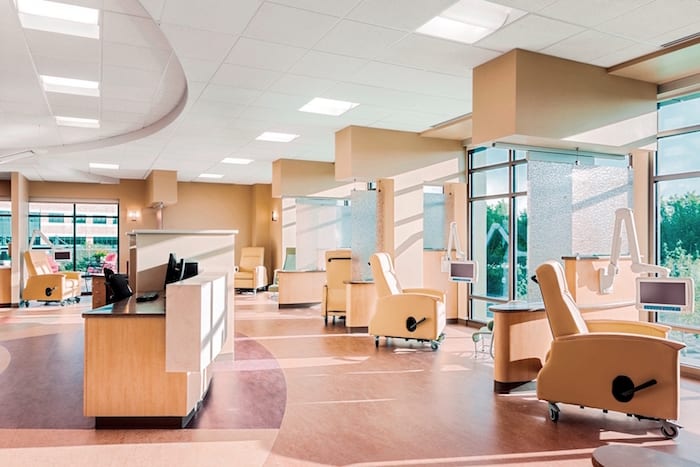Health Care Design Adapts to Meet Changing Industry

BUILDING DIALOGUE: Health Care Design
Health care design and development will need to continue to adapt to meet the demands of the ever changing health care industry. The evolving health care landscape includes changes to amenities and types/locations of hospital services, including clinics in retail facilities, more accessible outpatient facilities, free-standing emergency departments and micro-hospitals. The year ahead will see continued developments in how health care providers expect the architectural industry to design and equip their facilities to meet both patient and market needs.
As patients and families have become more sophisticated consumers, the health care provider systems have taken cues from the hospitality industry to embrace a customer focus. The trend is shifting outpatient services from traditional in-patient hospitals to more consumer-friendly environments. Increasing numbers of same-day services and procedures are being performed outside of hospitals, in community locations, which facilitates operational efficiencies and improves clinical outcomes, as well as enhancing customer convenience and satisfaction.
Micro-hospitals are now operational in multiple states across the U.S. These hospitals provide similar services to larger hospitals (emergency department, pharmacy, lab, radiology and surgery) in a smaller envelope, generally under 50,000 square feet. They are open 24/7 and maintain a limited number of inpatient beds for observation and short stays. Recent changes to Centers for Medicare & Medicaid Services reimbursement schedules for satellite facilities will make micro-hospitals an increasingly popular option.
Outpatient surgical centers provide convenient community access for surgeries that do not require an extended hospital stay. These are less expensive to build and staff, while catering to the suburban communities by providing easy access to care. They act as feeders to the larger hospitals when more acute care is needed.
Behavioral health accommodations are critical drivers for emergency department design.

UCHealth Cancer Center, Harmony Campus, Fort Collins, 30,000-square-foot expansion to a 140,000-sf MOB with 35,000-sf renovation of existing areas. Interiors by Gallun Snow; architecture by Heery; engineering by Martin/Martin and BCER; and construction byAdolfson & Peterson Construction. Courtesy Bob Soman
Hospitals recognize the need to accommodate impaired patients in the emergency department more effectively. With a greater awareness of untreated mental health conditions, along with the national opioid abuse crisis, hospitals realize the need to separate patients who pose a risk to themselves and others. Areas within the ED are being designed for people/families experiencing a crisis requiring behavioral-health or addiction-management intervention. These include places to securely store belongings, shower and space to decompress.
Acute care hospital construction continues to grow as baby boomers are aging. For the next 11 to 12 years, roughly 10,000 Americans will turn 65 every day. By 2030, about 18 percent of the U.S. population will be over age 65. Even with services pushed to outpatient facilities, the inpatients will be more acute, requiring longer stays and increasing the total demand for inpatient care.
New approaches in the design and planning of health care facilities are offering effective and efficient outcomes. Lean design and integrated delivery process are becoming the preferred project design process for many healthcare systems. This pulls the entire contingent of designers, architects, engineers and general contractors to the forefront with health care stakeholders to collaborate on the key needs and drivers for the facility. Using an IPD process allows the team to make decisions and manage budgets efficiently by having everyone at the table, while facilitating the navigation of state and local agency requirements.

UCHealth Carbon Valley Medical Center, Firestone, 15,300-square-foot outpatient MOB, including family practice, pediatrics, including telehealth medicine. Interiors by Gallun Snow; architecture by BSA Lifestructures; landscape architecture by BHA; design engineering by R&R Inc. and AEI; construction by Gilmore Construction. Courtesy Caleb Tkach, AIAP
Virtual reality is becoming a more common and effective planning tool for hospital design. In 2018, more health care clients will benefit from VR technology as they partner with architects and designers to imagine and design complex spaces. The architectural team can take VR equipment directly to end users to review design interactively and obtain immediate feedback. Technology continues to evolve as consumer needs change, and the design and construction industry will adapt to keep pace.
As other industries have experienced, when cost margins become pressure points, health care facility consolidation follows. Rural hospitals have been closing nationwide and hundreds more are at risk of closing in future years. Bloomberg reported a three-fold increase in health care bankruptcy filings in 2017, while Mayo Clinic announced a 2017 operating income over twice its operating income for 2016. Larger health care organizations will seek to capture revenue within their markets by diversifying to improve consumer outreach and increase physician referrals. To thrive, health care providers will be turning to strategies that maximize revenue and lower expenses. The health care design and construction industry will work to be a valuable resource in this ever-changing landscape.
msnow@gallunsnow.com
Published in the March 2018 issue of Building Dialogue.












